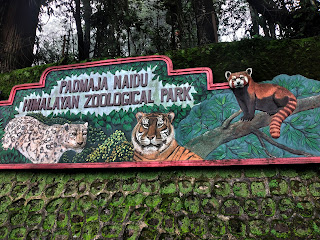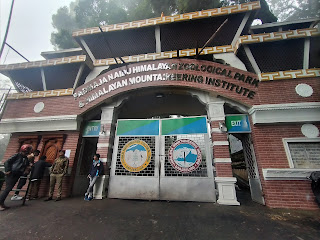Darjeeling Zoo
 |
Internationally acclaimed for its conservation breeding plug-ins of Red Panda, Himalayan Newt, Snow Leopard, Tibetan Wolf and many varieties of endangered species of Eastern Himalayas, DARJEELING ZOO has always been the best centre of visit for the tourists. It has been named as Padmaja Naidu Himalayan Zoological Park which was formerly called as Himalayan Zoological Park. Ever since it was established on 14th August, 1948 this particular zoo has only been progressed and witnessed larger developments till date. Owing to its huge area of 67.56 acres of land this zoo has everything that quenches the thirst of all age groups and every profession. It automatically becomes a must visit point for every tourist in Darjeeling. The zoo attracts more than 3 lakh visitors every year and still counting. It serves as the Central Zoo Authority of India’s Red Panda Program and is the member of World Association of Zoos and Aquariums.
Location
Darjeeling Zoo is the largest high altitude zoo in
India. It is located at an attitude of 7,000 ft. (2150 mts.) approx. at Birch
Hill (Jawahar Parvat). It is 85 kms from the Bagdogra airport. The railway
junction, New Jalpaiguri Station is also at the same distance and it is
connected with all the major cities and town of the country. It is around 3 kms
away from the busy Darjeeling town.
Contact
The office of the zoo may be contacted over phone in
0354-22-53709 / 22-54250 and via mail in pnhzp@yahoo.com.
Ideal Time to Visit
Darjeeling zoo can be visited at any time of the year.
However, summer, spring and autumn are the best as the animals tend to stay in
their shed during monsoon and winter. The temperature remains within 20°C to 26°C highest and 10°C
to 5°C to its lowest.
Timings and Ticket Price
The zoo remains open from 8:30 AM – 4:30 PM during the
summer season and 8:30 AM to 4 PM during winters.
The zoo remains CLOSED on Thursdays.
Ticket Price – The ticket is inclusive of zoo and HMI
that is located in the extended area of the zoo. The combined price of the
ticket is Rs. 110 for Indians and SAARC countries. Children below 6 years old are exempted. An
additional amount of Rs. 10/- is charged for those carrying cameras.
How to reach here?
Shared cabs are available from the Darjeeling bus
stand or the main market in Rs. 20/- per head. It will take about 15 minutes to reach.
Just below the zoo there is Lebong Cart Road where the
cars can be parked. For this roadside, one can take a 4-5 minutes uphill walk
to reach to the entrance gate.
One can also take the pleasure of walking for about 30
minutes from the Mall Road till the zoo entrance.
Charisma of the Zoo
Safe zone for Endangered Species
It’s an
absolute amusement to watch the endangered species like –
RED PANDAS are legally protected in India, Bhutan, China, Nepal and Myanmar due to their habitat loss and degradation, human interference and poaching.
We can get an opportunity to seeROYAL BENGAL TIGERSwhich is the national animal of India which is also an endangered species facing significant threats of poaching and habitat destruction.
ASIATIC BLACK BEARS are found here which has been enlisted as vulnerable in IUCN Red List and is threatened by deforestation and poaching for its body parts which are used traditional medicine.
TIBETAN WOLFis another endangered species enlisted in the Wildlife Protection Act of India (1972). Their reduced numbers and loss of forest habitat pose a major threat.
SNOW LEOPARD is likely to decline according to the World Wildlife Fund. Due to the constant threat of climate change, poaching and habitat destruction their total population is projected to decline by about 10% by 2040.
Collection of Wild Cats
Darjeeling Zoo is a great place to observe the wild cats. Snow Leopard was brought to the zoo from Zurich, the United States and the Leh-Ladakh. Black Panther and Royal Bengal Tiger are a great attraction. We can meet Samrat, the oldest Royal Bengal Tiger of the zoo. The view of these cats are of great experience particularly during the clear day and if one is lucky then we can get to see them roaring and walking to and fro in their enclosures. Hearing them growl from close can be quite thrilling. Other cats available are common leopard, jungle cat, leopard cat etc.
Herbivores and other Mammals
The zoo begins with the clear and wide look of Goral, Blue Sheep, Yak, Sambar Deer, Musk Deer, Barking Deer, and Himalayan Tahr etc. Meeting Mishmi Takin can be very interesting as it is the National animal of Bhutan and has also been listed under the endangered species due to the climate change and habitat destruction. They were brought from Berlin Zoo (Germany) to Darjeeling in 2019 as a part of exchange program. Darjeeling Zoo gave away two Red Pandas and got five takins as a part of this exchange program.
The zoo has a good collection of other mammals like
Himalayan Palm Civet, Jackal, Slow Loris, Monkeys and Langurs. It’s always a
great pleasure to see the Red Pandas playing and enjoying in the bamboos in
their enclosures.
Reptiles and Amphibians
Star tortoise, Himalayan Newt, Indian Cobra, Russel
Viper and many other species of snakes are uncanny yet alluring to watch.
Aviary
There is a nice aviary consisting of amazing Himalayan birds like Kalij Pheasant, Golden pheasant, Silver pheasant, Frey peacock pheasant, Himalayan Monal pheasant, ring necked pheasant, Reeve’s pheasant, Lady Amherst, Red jungle fowl, Alexendrine Parakeet, Rode-ringed Parakeet, Hill Myna, Grey Turaco, African Grey Parrot, Blue Gold Macaw, Green Pheasant, Cheer Pheasant.
CONSERVATION AND BREEDING CENTRE
It has been internationally acclaimed for the conservation breeding of endangered species like Red Panda, Snow Leopard and Tibetan Wolf. The captive breeding of the snow leopards was started in 1983. The zoo started the conservation program for red pandas in 1986. Darjeeling zoo is the first to release the red panda in the wild. The zoo welcomed two cubs of Snow Leopard on May, 2023 which has increased the population of snow leopard to 14 numbers now. The zoo also takes the pride of breeding Tibetan Wolf, Himalayan Tahr, Blue sheep, Himalayan Monal, Grey Peacock Pheasant, Himalayan Salamander and Blood Pheasant.
BENGAL NATURAL HISTORY MUSEUM
Another best fascinating place is this museum within
the locality of the zoo. This museum is aenthrallingsurfeit of more than 4000
specimens demonstrated. The ticket rate for visiting this museum in inclusive
with the zoo at the entrance. It consists of attractive display of well-
preserved fauna. This museum was earlier a part of Botanical garden that exhibited
varieties of butterflies and birds of the Eastern Himalayas. It was later on
was shifted to the zoo in the year 2010 due to the increase in the collections
and visitors. This now contains a large collection of zoological specimens set in
natural models with trees and landscapes that amplifies the splendor of thisperfectgallery.
LARGE SECTIONS – A beautiful way just opposite to the
aviary lead towards the museum with wide concrete stairs till the entrance. There
are two sections of the museum – Ground floor and First Floor. As soon as we
enter we will find the clear instructions of prohibition of photography,
videography, outside food, leaning on and touching the glass is displayed. The
visitors are requested to maintain discipline and complete silence inside the
museum. The entire museum is under CCTV surveillance.
There are glass cabinets in the ground section exhibiting the birds – eggs and nests of various birds and snakes are well preserved with labels on it, there are many birds like pheasants, spotted billed pelican, whistling thrush, Indian thick billed woodpecker, large thrush warbler, barbet etc. There are different journals of Museum’s quarterly bulletin in another cabinet since 1958 edition. It also consists of journals published by Ministry of Scientific Research.
There is a section dedicated to exhibit the five
bio-ecological zone of West Bengal. It begins from Marine Ecosystem inclusive
of starfish and corals. Then there are Sunderbans(Mangrove forests) with
preserved ducks followed by Wetlands, Tropical Rainforests and finally the Alpine
forests. A complete wetland ecosystem demonstrates various domestic birds and
migratory birds. A color pinned map is there that relates those migratory birds
with their original countries such as Siberia, Kazakhstan, East Asia, North
Asia and Central Asia. The mangrove forest has a spotted deer with a tiger cub
and just opposite to it there is a lake ecosystem.
There is an interesting section where different kinds of fish like katla, bagha, chega, pabda, snakes and reptiles like banded krait, king cobra, vipers, rat snake, coral snake, cat snake,star tortoise, giant leech are kept in bottles properly labeled with its local and scientific names. They also have babies of various animals such as bat, leopard cat, black panther, snow leopard, monkey, red panda, crab, freshwater snake, striped kukri snake, angler catfish, common krait, golden tree snake that is very rare to find under one roof.
The entomological section consists for numerous butterflies, moths and dragonflies with classic collection of bird nests with complete facts about them. There is another section for giving complete information about the harmful insects and there sting effects on human. The beetle collection is enormous. The silkworm section is very beautiful as it provides complete information about how is it processed and fabric is produced. There are numerous eggs of birds again and an entire section for the grasshoppers, bees, wasps and cicada too.
Moving forward to the birds section we can see severalvarieties
of woodpeckers, barbets, partridges, peacocks, peahens, owls, hornbills,
pheasants, Himalayan Monal, Kalij pheasant, sparrows, sunbirds, hill mynas,
crows, broadbills, flycatchers etc. Birds of prey section has mighty eagles and
vultures with Himalayan Griffin, Egyptian Vultures and others.
First Floor – As we climb the staircase towards the
first floor, we are accompanied by a huge flat skin of Mihmi Takin (National
Animal of Bhutan), head mounts of wild animals like Gour, Kashmir Stag, Royal
Bengal Tiger, Wild Boar, Asiatic Black Bear.
The whole first floor is devoted to the mammalian section. It has the Estuarine crocodile (17.2 fts. in length) in a glass box right in the left side near the balcony.
The Himalayan ecosystem displays Yellow Throated Martin, Eurasian Lynx, Pheasants, Common Leopard, Golden Cat, Marbelled Cat, Mongoose and Civet. Another section showcasesSnow Leopard, Asian Palm Civet, Indian Flying Fox, Himalayan Black Bear, Chinese Pangolin of 1758 and Tiger with cubs. Different kinds of squirrel with flying squirrel, Indian fox and bats are wonderful to watch. There are Royal Bengal Tiger and Red Pandas in another glass section. A hugeflat skin of yak with head mount allows gettinga close look.
Head mounts, skulls and antler ofAntelopes, Barking
Deer, Gour, Barasingha, Black Buck, Serow, hog deer, Nilgiri Tahr, Marco Polo
sheep, Great Tibetan sheep, takin, goral, Chinkara or Indian Gazelle, the Ibex,
Shou, yak and others. A glass box has Elephant tusks presented by Shri S.S Ray,
Chief Minister of West Bengal on 2nd September 1976. Next there is a
collection of rhinoceros feet also. The head mounts of wild buffaloes with grand
horns are really great. The flat skin of tiger with its skull is nice. A
separate section has elephant tusks, feet and molar teeth in it.
The flat skin of bear with mounted head is kept in the
next showcase followed by the flat skin of snow leopard with its head mount, footprints
and claws. Finally there is a section which has an Indian elephant’stusks and
feet that was recovered from a tusker that was found dead on River Teesta bed
near Laltong.
Prime Visitors
The National and International Tourists are the major
visitors of this best zoo of India. A lot of students visit for educational
tours and excursions. The premises is also filled with the research scholars
from the field of zoology, environmentalists and many more.
Delicacies to relish
Gurash Restaurant is the only cafeteria within the zoo locality. It is a small cafeteria which has limited seats inside but there are a number of dining tables outside with garden umbrellas. Several beverages like cold drinks, tea, coffee, juice, ice-cream and light snack items are available here. One can sit, relax, eat and then move on towards the HMI or Museum which is located very close.
Just outside the zoo entrance we can see many stalls
of eateries line up below one turning. We can enjoy the street food such as
momos, bread omlette, bhuja, jhaalmuri, chana chola, aaloo bhuja, aaloo thukpa,
bun omlette, chowmein, thukpa etc.
Planned Activities
Research –The zoo is a paradise for those research
scholars who want to do a good study of the animals and their behaviour
pattern, food habits, life cycle and many more.
Shopping –Souvenirs can be bought for a wide range of
shops that’s just near the entrance of the zoo. There are many such shops once
we come out of the gate and walk downhill towards the Lebong Cart Road.
ADOPTION PROGRAMME
There is an exotic opportunity where one can adopt and
pay for their care, by entering into a contract with the zoo management. By
adopting any endangered animal species, we can practically participate in the
conservation of the rich heritage. All the donation and adoption are exempted
U/S 80G Income Tax 1961. We can also get a framed official certificate of
adoption. It is a great activity that can be performed on our special days.
Parents love to gift it to their children and make them contribute whatever
they can and enjoy the pride of helping the nation to conserve those who are in
jeopardy.
Exploring Duration
One can enjoy the entire charm of the zoo if 2-3 hours
are invested. Otherwise just to have a roundabout might take around 1 to 1.5
hours. Wheelchairs are available at nominal charges for those who are senior
citizens. There is a public washroom just near the entrance. Drinking water
facility is available close to the aviary section. There is a map of the zoo
for strategizing the complete exploration.
Since the area is really wide there are lots of rest
benches and rest-houses at regular intervals. These benches particularly help
to cherish the exploration without taking a huge stress of covering long and
strained walk.
Cleanliness and Maintenance
The entire area of zoo is well maintained by the authorities. The zoo keepers and security guards are all over every turn of the road. Even though the area is under camera surveillance yet they are always there to guide and assist the daily visitors. It becomes vital to maintain strict discipline in the premises by the visitors so that the animals do not get disturbed by any kind of human interference. Speaking loudly, feeding, teasing or screaming is strictly prohibited and checked round the clock. The cleaners are seen at work the whole time. The dustbins are placed at every bend so that the cleanliness in well maintained by the tourists.
The zoo also strives for maintaining ecological
balance in the Eastern Himalayas with the mission of Ex-Situ conservation and
Captive Breeding of endangered Himalayan animal species. They tend to educate,
motivate and initiate awareness campaign among the local people as well as
visitors on the importance of conservation of Himalayan Eco-System. They have
the objective to initiate applied research on animal biology, behavior and
health care.
TIPS TO VISIT THE ZOO
1.
Plan any day
to visit except Thursdays.
2.
Wear comfy
clothes and shoes suitable for all weather and terrain.
3.
Carry water
and light snacks it’s a huge area to be covered.
4.
Follow the
park rules strictly.
5.
Respect the
privacy of the animals.
6.
Have enough
time to spend.
Conclusion
Darjeeling zoo is a high altitude specialized zoo
housing the fauna species of Eastern Himalayan Region. It is well known across
the world for its breeding and conservation efforts. This zoo is the first zoo
to earn the renowned international award “The Earth Heroes” in 2014. This is a
place that is a pride in itself for being able to uphold the objectives that
was envisioned by the pioneers of its origin. One can never get dissatisfied
after visiting this enticing place in Darjeeling.

































0 Comments